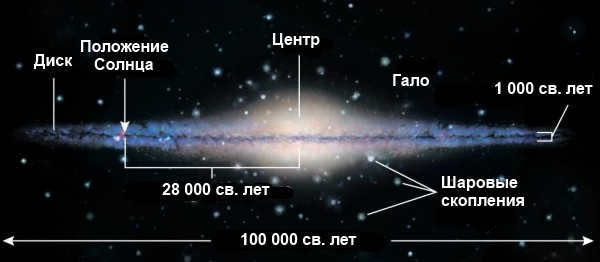Authored by Andrei Konstantinov
Published on September 19, 2013, at 00:00
On the 12th of September, NASA made a groundbreaking announcement stating that the Voyager 1 space probe, after an incredible 35 years of interstellar travel, has finally exited the boundaries of our solar system. This revelation has left many pondering the mysteries that lie beyond.
Similar to the intrepid explorers of old who meticulously mapped out the newly discovered islands and continents, contemporary astronomers are continuously adding more and more celestial bodies to the ever-expanding map of the Universe. We have already come to comprehend that our home, planet Earth, is one of the many orbiting bodies in the Solar System. We revolve around the center of the spiral galaxy known as the Milky Way, which itself is a constituent of the Local Group of galaxies, situated within the vast expanse of the Virgo Supergroup.
In the observable Universe, there exists an astonishing number of over 100 billion galaxies, with an average of 100 billion stars within each. The sheer magnitude of this celestial expanse is difficult to fathom, especially when considering the fact that countless potential worlds are awaiting our exploration. However, it is disheartening that despite this immense cosmic playground, humanity has yet to master the ability to venture beyond our own planet. At the current rate of travel, it would take an unfathomable 10,000 years to reach the nearest star.
Organization of the Cosmos
(derived from information provided by the Millennium simulation project. Springel et al., 2005)
Clusters of galaxies amalgamate to create superclusters, which in turn generate filaments, the strands of an enormous interconnected network of matter, interspersed with vast expanses – enormous chasms of empty space. In this computational representation of the organization of the Universe, yellow represents matter, black signifies the absence of matter, and purple represents the enigmatic dark matter that can only be observed indirectly. Each yellow dot corresponds to an individual galaxy, while larger marks denote clusters and superclusters of galaxies.
Spanning a distance of 564 million light-years.
The solar system
Encompassed by neighboring stars (Adapted from an illustration by Andrew Z. Colvin /wikimedia.org)
In the vicinity of the solar system, within a span of around twelve light-years, there exist stars that hold familiar names within the realm of science fiction enthusiasts – Sirius, Altair, Tau Kita, Epsilon Eridanus… The nearest star system to us is Alpha Centauri, which consists of three stars and is situated at a distance of 4.3 light-years from Earth.
40 light years (the dimensions of a cylinder)
The Local Group of Galaxies: A Unique Cosmic Collection
Credit: Figure by Andrew Z. Colvin / wikimedia.org
Gravity, the primary force that unites the vast expanse of the universe, plays a crucial role in holding together a distinctive assembly of celestial objects near our vicinity. This extraordinary congregation consists of two major galaxies and approximately one hundred dwarf galaxies. Among the closest members are the Dwarf Elliptical Galaxy in Sagittarius, which serves as a minuscule satellite in the grand scale of the Milky Way, and the Magellanic Clouds, which captivate the naked eye with their visible presence. Alongside these smaller entities, we find two remarkable spiral galaxies: the Andromeda Nebula, boasting a size twice that of our own Milky Way, and the Triangle, which also dwarfs our galaxy in terms of size. While the universe continues to expand, causing distant galaxies to gradually vanish over the event horizon, the Local Group galaxies will forever remain in close proximity to us. In fact, billions of years from now, the Andromeda Nebula is expected to merge with our galaxy, creating a spectacular celestial event that will leave a lasting impact.
Spanning a vast distance of 4 million light-years.
The Milky Way Galaxy
This representation of the Milky Way Galaxy is a creation of NASA, using data collected by the Spitzer orbiting telescope. The image was captured by R. Hurt from JPL-Caltech, a division of NASA.
The Milky Way is an average spiral galaxy with a typical structure. Its vast collection of 200 billion stars is primarily concentrated within a disk that spans approximately 3,000 light-years in thickness. Situated at the center of this disk is an immense black hole, surrounded by cosmic gas. Extending outward from the center, the disk stretches a distance of 50 thousand light-years to its edge.
Surrounding the disk is a shell of interstellar gas, and current theories suggest that the entire galaxy is encompassed by a massive cloud of dark matter, which extends 10 times beyond the disk’s radius. Our own star, the Sun, resides within the Orion arm of the Milky Way, positioned at a distance of 25 thousand light-years from the galactic center. As the star orbits around the center, it maintains a speed of 220 km/s, completing a full revolution in one galactic year, which is equivalent to 200 million Earth years. Moving closer to the galactic center, the density of stars increases by a factor of 1,000, while the center itself remains hidden from our view due to the presence of cosmic gas and dust clouds.
A circle with a diameter of 105,000 light years.
4. Findings from the sociological survey. Appendix 1
5. Creation of a visual representation. Appendix 2
7. Compilation of sources and references used.
Project objective: to determine our position in the Universe using the latest astronomical discoveries.
Identify the key celestial objects associated with the location of planet Earth in the Universe;
gather information to describe intriguing facts about the chosen objects;
develop a visual aid on the project’s topic.
theoretical analysis and synthesis of scientific literature;
survey of classmates using a questionnaire on the project’s subject.
Theoretical importance of the project:
to acquire fundamental astronomical knowledge, which will enable further exploration of astronomy;
To engage students in the field of astronomy and captivate their interest in the fundamental inquiries of the universe is the primary goal of this project. Its practical significance lies in its potential use by students to enhance their educational level, as well as by elementary school teachers, geography and physics teachers to elucidate new topics and facilitate engaging lessons.
“The abyss is teeming with stars, countless in number, reaching unfathomable depths” – these words of the eminent Russian scientist M.V. Lomonosov highlight the vastness and mystery of the universe.
Our location in the Universe serves as a thought-provoking subject.
Introduction and thorough examination of relevant literary sources.
Exploring “Our home: Planet Earth” as an essential starting point.

The Earth is an enormous celestial body with a mind-boggling mass of 6 x 10 24 (6 septillion) kilograms.
The estimated age of Earth’s formation is 4.5 billion years ago. The entire process of planet formation lasted around 10-20 million years.
Our atmosphere, a vast ocean of air surrounding the Earth’s surface, is composed of 78% nitrogen, 21% oxygen, and 1% other gases. This protective layer of air gives rise to a diverse range of weather conditions on Earth, shielding all living organisms from the harshness of space. It also safeguards us against harmful solar radiation and the impact of meteorites. Through the atmosphere, the Earth’s surface receives electromagnetic radiation from the Sun, which serves as the primary source of energy on our planet.
At the center of our planet lies a rapidly spinning molten core composed of nickel and iron. It is this rotation that gave rise to a magnetic field roughly 3.5 billion years ago, serving as a shield against the solar wind and transforming it into mesmerizing auroras.
The Earth completes one full rotation around its axis in an average of 23 hours, 56 minutes, and 4 seconds, leading to the cycle of day and night that we experience.
With an average velocity of approximately 30 km/sec, the Earth orbits the Sun at a distance of around 150 million kilometers. As it travels along its orbit, the Earth completes a full revolution in about 365 days, marking the passage of one sidereal year.
Accompanying our planet is a solitary natural satellite known as the Moon.
The first individual to behold the Earth from the vastness of space was Yuri Gagarin, who achieved this feat in 1961.
The Earth is inhabited by a vast array of living organisms, including humans. According to the United Nations, the global population stood at 7.3 billion as of July 2016, with estimates suggesting it will reach 9.2 billion by 2050.
By January 1, 2018, a total of 556 individuals have ventured beyond Earth’s atmosphere, with 12 of them having set foot on the Moon. Among these space explorers, 60 were women.
Our planetary home: The Earth and its group of planets
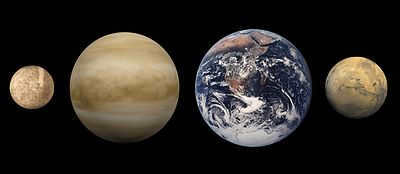
Relative sizes (from left to right) of Mercury, Venus, Earth, and Mars.
The planets that orbit the Sun can be classified into two categories: the Earth-group planets and the giant planets. Our planet can be found in the Earth-group. The terrestrial group consists of Mercury, Venus, Earth, and Mars. These planets were named after their similarity to our Earth. The examination of these planets has revealed that they all possess small sizes and, most notably, masses. Earth happens to be the most massive among the terrestrial planets.
Mercury, the closest planet to the Sun and the smallest among the four, has a surface covered in craters. This is a result of its extremely thin atmosphere.
Mercury experiences extreme temperatures, ranging from a bone-chilling -180 °C to a scorching +430 °C, setting it apart from other planets.
Mercury completes a full orbit around the Sun in just 88 days, thanks to its incredibly close proximity (with an average distance of just under 58 million kilometers) to the Sun. Interestingly, the planet rotates very slowly, with a day on Mercury lasting 59 Earth days.
Mercury is never visible in a dark sky. The best time to observe the planet is during morning or evening twilight when it is at its farthest distance from the Sun in the sky, which occurs several times a year.
Mercury does not have any natural satellites.
This celestial body is similar to Earth in terms of density and size. It possesses an incredibly dense atmosphere. Despite being further away from the Sun than Mercury, Venus is the hottest planet in our solar system, with an average temperature of +470 °C. A single day on Venus lasts an astonishing 243 Earth days, while a year spans 225 days. Venus is a captivating and radiant presence, often appearing as the Morning Star.
This magnificent planet has a mass approximately 10 times greater than that of Earth.
With an atmosphere composed mainly of carbon dioxide, Mars is the coldest planet in our solar system, experiencing temperatures that range from -153 °C at the pole during winter to over +20 °C at the equator at midday. The average temperature on Mars is -50 °C.
A solar day on Mars lasts 24 hours and 39 minutes, making it nearly identical to a day on Earth. However, the Martian year is significantly longer, lasting 689 days.
On Mars, there are no liquids, but rather frozen ice caps of gas and water. The planet is well-known for its volcanoes, craters, and two moons, Deimos and Phobos.
Currently, Mars is the second most thoroughly examined planet in the solar system, coming after Earth.
The Solar System: Our Place of Residence
The Solar System is our celestial residence. There are merely eight planetary abodes, but there is also the Sun, comets, the asteroid belt, the Kuiper belt, the Oort cloud, dwarf planets, and a plethora of cosmic debris. Regrettably, the other dwellings remain unoccupied, leaving us without any neighbors.
Situated at the heart of our complex is the luminous star, the Sun. The Sun is an immense luminous sphere composed of hydrogen and helium gases.
The formation of our solar system transpired from a cloud of gas and dust approximately 4.57 billion years ago.
Jupiter, the largest planet in our solar system, boasts an equatorial diameter of 143,000 kilometers, which is 11 times the circumference of the Earth. In fact, Jupiter is so colossal that its mass exceeds the combined mass of all the other planets in our solar system by 2.5 times.
Mars is home to the largest mountain in our solar system, Mount Olympus, which stands at a towering height of 21 kilometers.
The biggest moon in the solar system is Ganymede, which belongs to Jupiter and has a size of 5268 km. If Ganymede were in orbit around the Sun, it would be classified as a planet.
Our planet has a special significance in the solar system as it is the only one known to support life!
Our location: the Milky Way and Orion’s arm

The Milky Way, the star system that our solar system is a part of, is an immense and captivating galaxy. It is estimated that there are at least 200 billion stars within the Milky Way, making it a truly vast and awe-inspiring place.
In the 18th century, the English astronomer William Herschel conducted the first comprehensive study of our galaxy, providing valuable insights into its structure and composition.
Classified as a spiral galaxy, the Milky Way is characterized by its spiral arms, which give it a distinct and beautiful appearance.
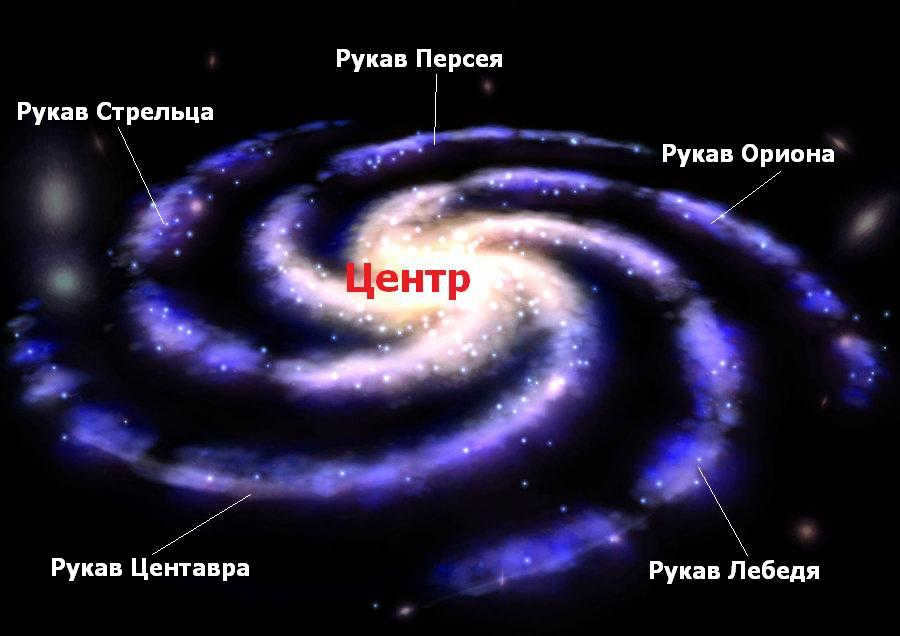
The formation of new stars is an ongoing process in the spiral arms, which wrap around the nucleus in a semicircular manner. Currently, there are five arms in the Galaxy: the Swan arm, the Perseus arm, the Centauri arm, the Sagittarius arm, and the Orion arm, which contains our solar system.
The center of the Galaxy, located in the direction of the Sagittarius constellation, is considered one of the most fascinating areas.
It is believed that at the very center of the Galaxy, there exists a massive object – a black hole with a mass equivalent to about a million times that of the sun.
Alongside all nearby stars, the Sun orbits around the center of the Galaxy at a velocity of 200-220 km/s, completing one revolution in approximately 220-250 million years. Hence, throughout its entire existence, the Earth has completed no more than 30 orbits around the center of the Galaxy.
Our galaxy possesses neighboring celestial bodies such as the Large and Small Magellanic Clouds, as well as the Andromeda Galaxy.
The Milky Way, in conjunction with the Andromeda galaxy, can be viewed as the main thoroughfares within our cosmic metropolis – the Local Group of Galaxies. These two colossal galaxies within the group exert a gravitational pull on one another and will eventually collide. Additionally, there are numerous smaller “streets”, primarily satellites of the larger galaxies. In total, our group consists of over 50 galaxies.
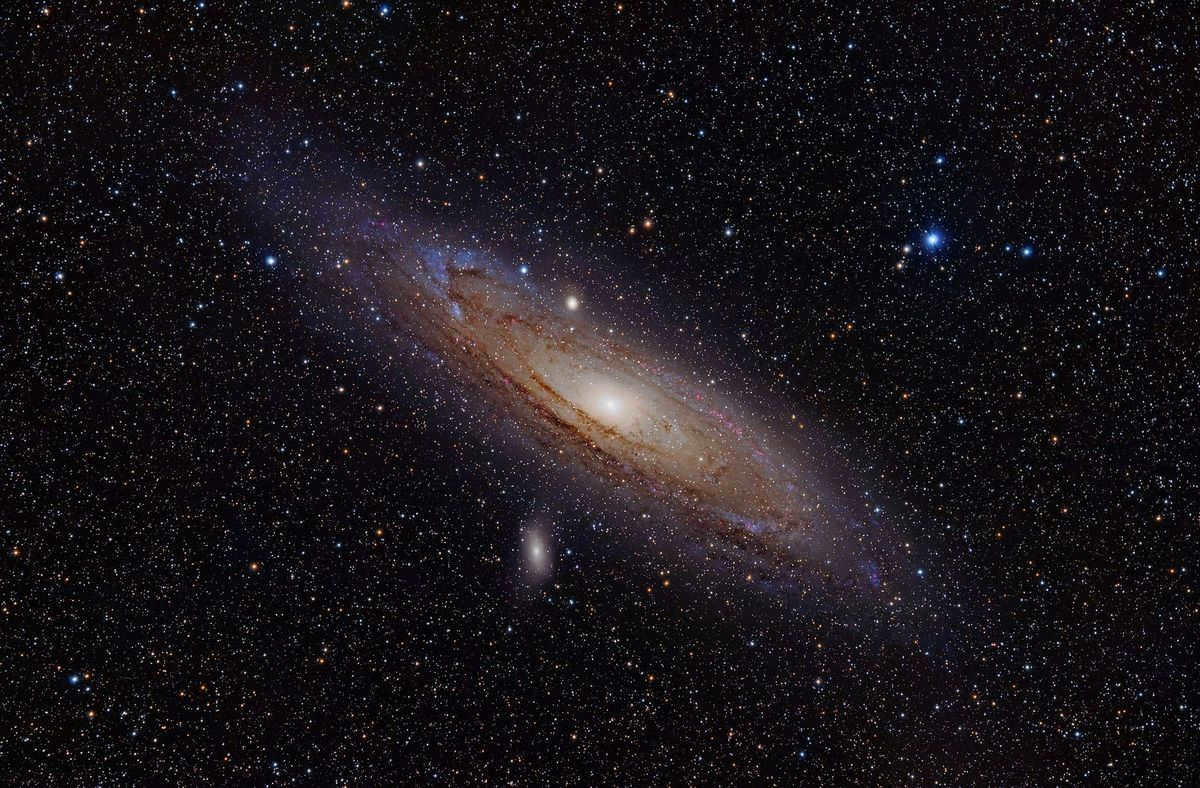
Our location: the Virgo supercluster
The nearby cluster of galaxies is a component of the Virgo galaxy supercluster, which includes galaxies within a distance of 200 million light-years and consists of approximately thirty thousand galaxies.
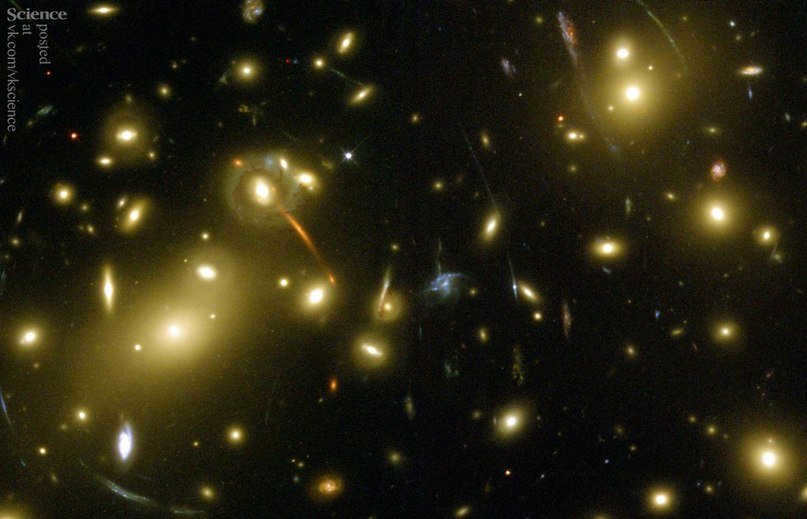
So, the scope is absolutely staggering. But what comes after? And then comes the portion of the Universe that we are able to perceive through all the instruments at our disposal – it is referred to as the Metagalaxy (Observable Universe).
Consequently, the “cosmic location” of our planet within the Universe is as follows: Metagalaxy, Laniacea, Virgo supercluster, Local Group of Galaxies, Milky Way Galaxy, Orion Arm, Solar System, Earth Group Planets, Planet Earth. As you wish!
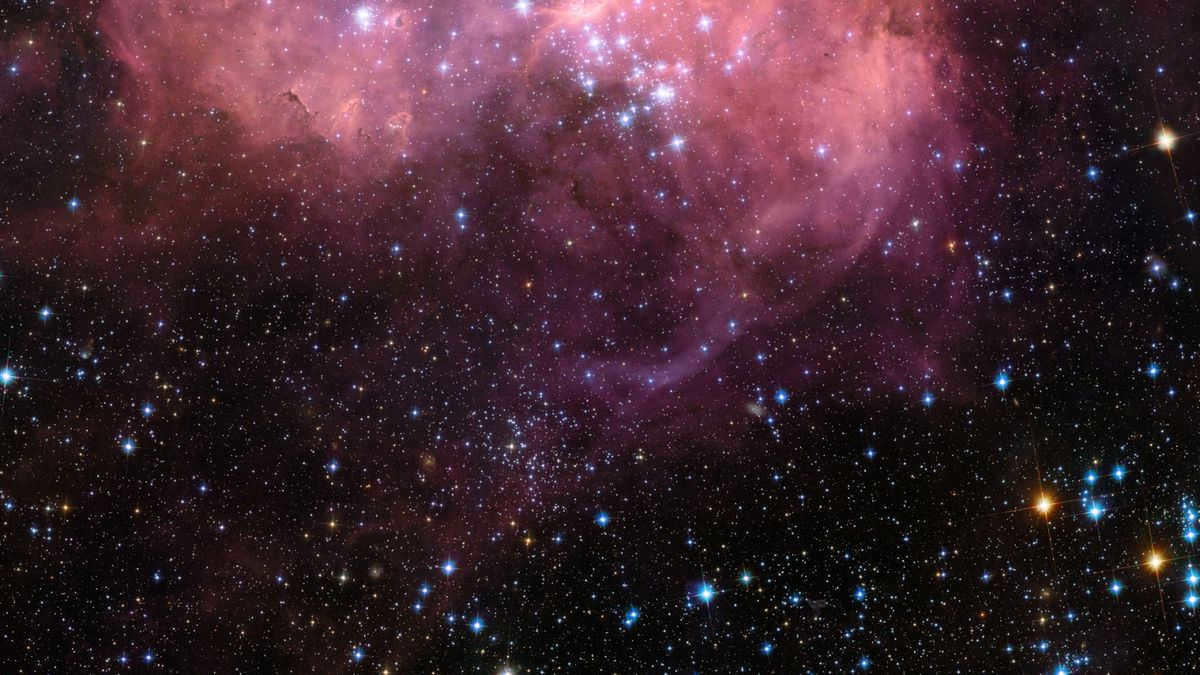
The findings of the sociological investigation
In order to ascertain the level of knowledge among my peers regarding specific astronomy-related questions pertaining to the project theme, I conducted a survey consisting of 22 participants. The results can be found in appendix 1.
The responses provided by my classmates in the questionnaire serve as further evidence that the study of astronomy is of utmost importance. In the 21st century, it is inconceivable to not possess a fundamental understanding of the universe.
After completing my project, I gained a wealth of new knowledge and, more importantly, I have developed an insatiable curiosity about the world around me – the planets, the stars, and the distant galaxies. Perhaps, when I grow up, I will be the one who unveils the mysteries of the cosmos! As evidence of my project, I am proud to present a visual aid – a poster. Please see Appendix 2 for details.
Below is a list of the sources and literature that I used:
1. Popular science documentary series “Space: Space and Time”, 2014.
As inhabitants of the beautiful planet Earth, you and I are about to embark on an extraordinary journey into the vastness of space. Our goal? To determine our place in the universe.
Before we begin, it is useful to understand how to measure distances, as it can be quite challenging to comprehend them in simple kilometers.
1 light year is defined as the distance that light travels in the span of one year, while moving at a velocity of slightly less than 300,000 km per second.
Another way to express this vast distance is to say that 1 light-year is roughly equivalent to 9,460,000,000,000,000,000,000 kilometers.
It is truly mind-boggling to think that the nearest star to our planet is located a staggering 4.2 light years away. In other words, it would take light, traveling at a speed of 300,000 km per second, a total of 4 years to reach this star! The distances in outer space are simply incredible.
First destination: the solar system
As we are all well aware, we find ourselves within the confines of the Solar System. Taking center stage in this celestial arrangement is none other than the Sun.
Much like our very own planet, which dutifully revolves around this fiery star, the Sun itself orbits the Galaxy’s center at a brisk pace of 220 km/s. Its distance from said center measures approximately 27,000 sv years.
The next stop: the Orion arm
Our particular star system is nestled within one of the Galaxy’s four distinguished arms, known as the Orion arm. Extending approximately 3,500 sv years in thickness and 10,000 sv years in length, this arm is a sight to behold.
It is worth noting that the Orion arm, in turn, resides within the vast expanse of the Milky Way galaxy.
The next destination on our journey is the Milky Way galaxy
Spanning approximately 100-120 thousand light-years in diameter, the Milky Way is a magnificent sight to behold.
Located at the heart of this vast galaxy is a supermassive black hole, boasting an astounding mass of around 4.2 million times that of our Sun. Surrounding this colossal entity, there are also smaller black holes, which range in mass from 5-10 thousand solar masses, as well as thousands of relatively petite ones.
The central regions of our galaxy are renowned for their high concentration of stars. The gaps between these celestial bodies are significantly smaller compared to the distances observed within the Local Group of galaxies.
The next destination on our journey is the group of galaxies known as the Local Group.
Consisting of our very own Milky Way, as well as the Andromeda Galaxy, the Triangle Galaxy, and an additional 54 galaxies, the Local Group is a fascinating collection of celestial bodies.
Spanning an impressive diameter of 10 million light years, the Local Group is a true marvel of the universe.
Our adventure continues as we make our way to the Virgo cluster.
Interestingly, the Local Group is actually a part of the larger Virgo cluster.
Stretching across an astounding diameter of 15 million light years, the Virgo cluster is home to approximately 2,000 galaxies.
Stop six – Virgo super cluster
The Virgo cluster is an incredibly strong cluster of galaxies located in the heart of the Virgo supercluster.
Comprising approximately 100 galaxy clusters, the Virgo cluster is a true marvel of the universe.
Spanning a diameter of over 200 million light years, the Virgo supergroup is just one of countless superclusters that exist within the observable Universe.
The next destination on our journey is the Laniakea supergroup.
Within the immense Laniakea supergroup lies the Virgo supergroup.
Laniakea stretches across a vast expanse, with a diameter of approximately 520 million sv years.
Containing a staggering number of approximately 100,000 galaxies, Laniakea is a truly remarkable sight.
Comprised of four distinct parts, the Laniakea supergroup is a cosmic marvel:
– The Virgo superunion, which includes our very own Milky Way;
The eighth destination on our journey is the Pisces-Keith superscope complex
At long last, we arrive at the Pisces-Keith superscope complex, a part of the Laniakea Superscope (galactic filament) that stretches an impressive 1 billion sv years. This complex is among the largest structures ever discovered in the vast expanse of the Universe.
While remarkable in size, the Pisces-Keith superscope complex is actually 10 times smaller than the Great Wall of Hercules-North Corona, which holds the distinction of being the largest structure ever observed in the Universe. Surprisingly, our very own Virgo super cluster, impressive as it is, accounts for a mere 0.1% of the total mass of this complex.
Just as every person has their own unique address, our planet Earth also has its own cosmic address. The question remains, where exactly is this address located and how does our planet move through space? Let us delve into these mysteries and seek the answers we seek.
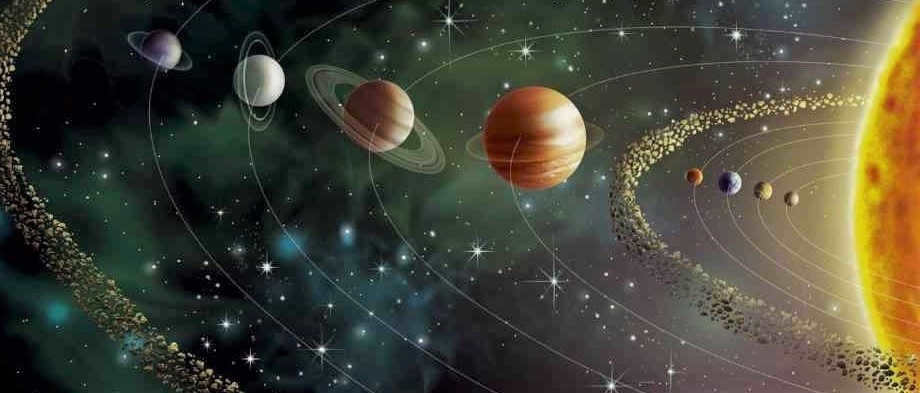
Earth’s Galactic Position
It is highly probable that the astronomical residence of Earth can be traced to its location within the vast expanse of outer space.
It is a well-known fact that Earth is situated within the solar system, with its planets orbiting around the Sun. Furthermore, this solar system is part of the larger Milky Way galaxy. One intriguing characteristic of our galaxy is the presence of five arms, classifying it as a spiral galaxy in the eyes of astronomers.
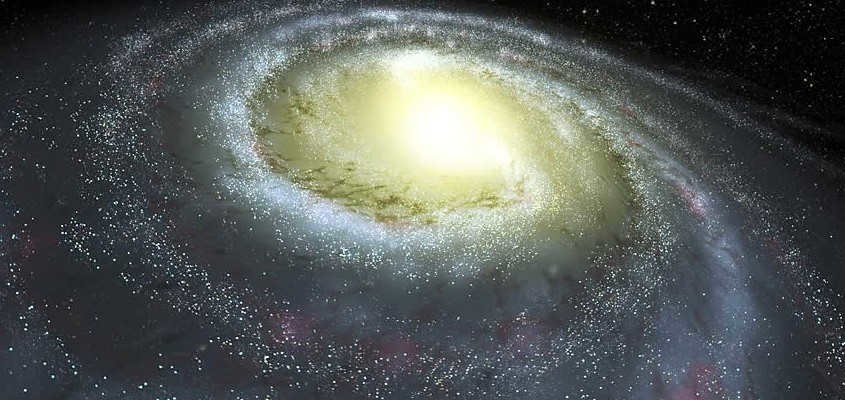
It appears that our solar system can be found within one of these arms, specifically the Orion arm.
There exists a gravitational link between galaxies in the vast expanse of outer space. The local group is formed by our Milky Way, along with the neighboring galaxies Andromeda and Triangle, as well as several smaller galaxies.
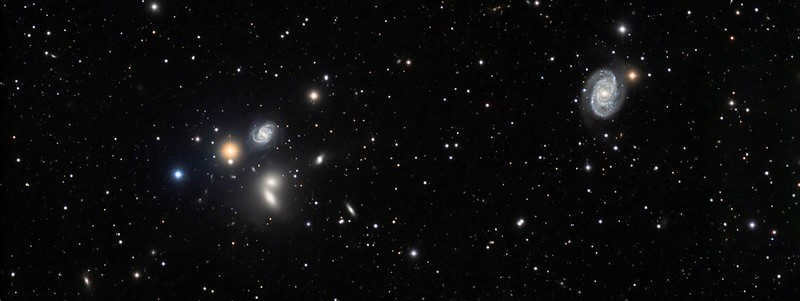
Furthermore, the arrangement of galaxies in the local supergroup follows the same principle.
The supergroup gives rise to a cosmic filament. These cosmic filaments are the largest assemblages of celestial objects in the Universe. Our location falls within the Perseus-Pegasus filament.
This is how, step by step, we have determined the celestial coordinates of planet Earth in the vastness of outer space.
Measuring the Distance in Space
Astronomy typically employs its own established units of measurement.
The immense expanse of space necessitates the use of larger scale methods of calculation than what we are accustomed to. Hence, scientists have developed a handful of fundamental measures of measurement.
The Astronomical Unit
This refers to the radius of the Earth’s orbit around the Sun. More precisely, it amounts to 149,597,870,700 meters.
Light-year
The light-year is equivalent to 63,241 astronomical units (AU) or 9,460,730,472,580 kilometers. It represents the distance that light travels in a vacuum within the span of one Earth year. It is worth noting that while this unit of measurement is commonly utilized in literature, it is not typically found in scientific publications.
Parsec
A parsec is defined as the distance to a star that exhibits an annual parallax equal to one arcsecond. More precisely, it is equal to 3.2616 light-years, approximately 206,264.8 AU, or 3.0856776×1016 meters.
Discover these techniques for accurately determining the separation between objects within our solar system.
The radiolocation method employs the utilization of a radio signal, which is transmitted to the object of interest, and the round-trip travel time is measured. Unfortunately, the application of radio signals is only feasible for short distances.
For more extensive measurements, the laser location method is employed.
In this approach, a beam of light is dispatched in lieu of a radio signal. By utilizing this beam, the distance to the object being investigated is calculated using the same procedure. It is important to mention that this method is highly precise.
The technique of trigonometric parallax
This approach is a less complex way of determining the distances to the most distant celestial objects.

Recalling the principles of geometry, we can start by drawing a line segment connecting two points on the Earth’s surface. Next, we can select an object in the sky to serve as the highest point of our triangle. To proceed, we will need to measure the angles formed between the line segment we drew earlier and the lines connecting the vertex to the two endpoints. With these measurements in hand, we can then calculate the remaining sides and angles of the triangle.
Method of standard candlesticks
The standard candlestick method is utilized in the measurement of distances within other galaxies.
It is a well-known fact that light sources become less bright as their distance increases. This principle serves as the foundation for this particular technique. Though it may not yield highly precise measurements, it still holds its place in the field.
Determining distances in the cosmos is an intricate and time-consuming process that demands considerable attention. However, the human mind has successfully overcome more challenging tasks in the past. The accomplishments and breakthroughs of scientists are truly commendable.
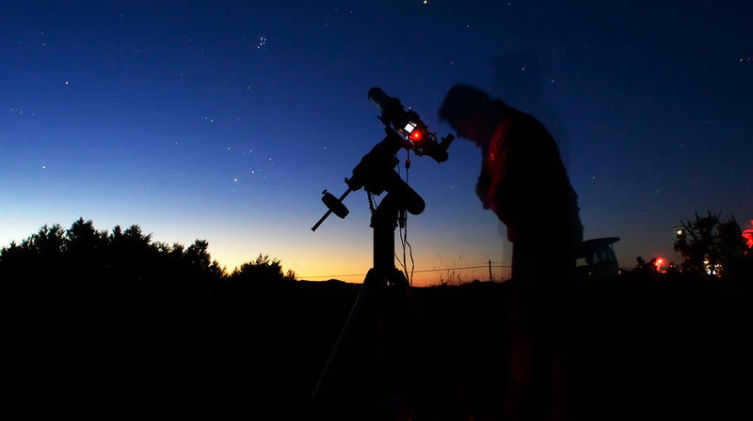
The position of our planet in the vast expanse of the Universe serves as our cosmic location. What purpose does it serve? It doesn’t need to be listed in official documents or written in passports – so perhaps it’s best to omit it altogether?
However, this viewpoint originates from an individual residing in the thirteenth century A.D., who believed that his village encompassed the entirety of the world. He presumed that the sun would set beyond those hills and rise above this particular rivulet. In contrast, a modern-day individual should possess knowledge of their astronomical location, as our divergence from our ancestors extends beyond mere internet usage to encompass a comprehensive comprehension of the world.
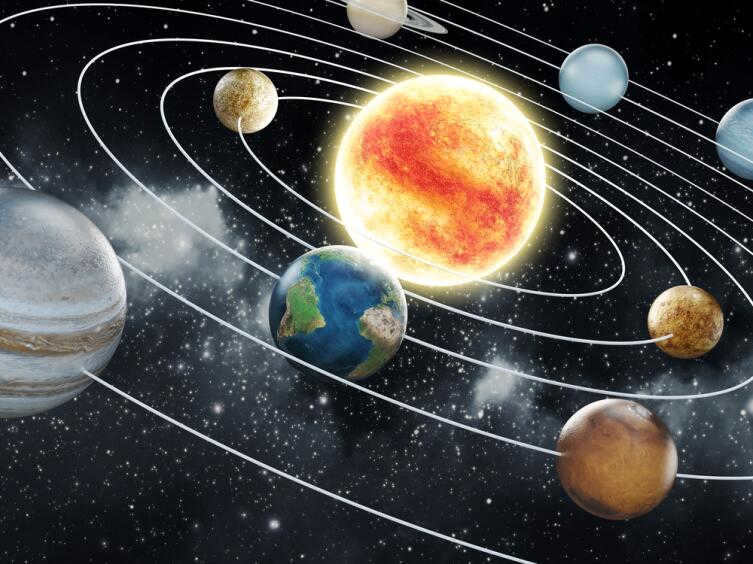
Exploring the Solar System, Starting with Earth
Our journey through the vast expanse of the cosmos begins right here on our home planet, Earth. This incredible celestial body is anything but ordinary, boasting a one-of-a-kind atmospheric composition, vast oceans that span its surface, and a robust defense system against harmful radiation consisting of a magnetic field, ozone layer, and ionosphere. Situated at a distance of 1 astronomical unit from the Sun, Earth serves as our launchpad into the wonders of the solar system.
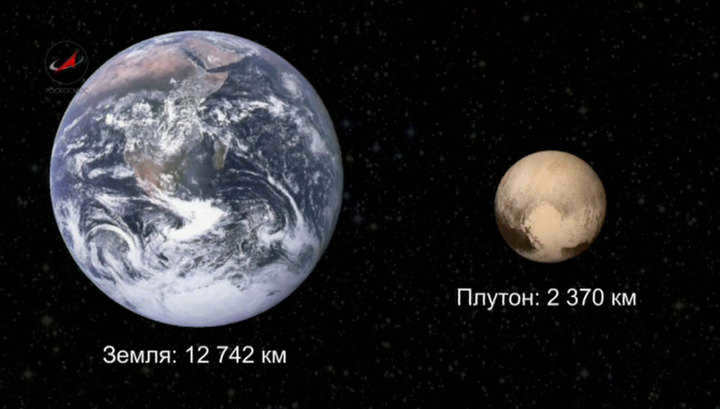
It’s not difficult to guess that the concept of an astronomical unit was created as a point of reference. If we convert this distance into kilometers, we obtain the maximum distance between the Earth and the Sun – Aphelion, which is approximately 152 million kilometers. That is the distance our planet is from the Sun. Or is it still considered close? Photo: Depositphotos
It’s truly fascinating to contemplate our position in the vastness of the cosmos. Within our solar system, Earth is just one member of the terrestrial planet group, which also includes Mercury, Venus, and Mars.
Journeying from the Sun to the Milky Way
But let’s delve deeper – we’ve come to realize that we reside among the terrestrial planets within the Solar System, with the central star being the Sun. To grasp the enormity of it all, it’s worth noting that our Sun, which appears as a small radiant orb from Earth, actually boasts a diameter that’s nearly 109 times larger than our home planet.

Undoubtedly, the Sun is also a constituent of a much larger system. This system is none other than our very own galaxy, known as the Milky Way. On a clear night devoid of the moon’s illumination, one can observe a misty streak stretching across the entire sky. This is the visible part of our galaxy. By employing a pair of binoculars to examine this streak, we are able to discern an immense multitude of stars. In fact, there are approximately 200 billion stars present within the Milky Way, excluding the Sun. However, certain scientists suggest that this number may be twice as large. All of these stars collectively form a colossal spiral structure that rotates around its core.
Photo: Depositphotos
Our Sun is located in one of the branches of the spiral galaxy, specifically in the Orion arm, rather than in a central position among the multitude of stars. Similar to billions of other celestial bodies, our Sun orbits around the central point of the galaxy. However, our Sun is situated closer to the outer edges, approximately 26,000 light years away from the galactic center. Consequently, if we were to travel at the speed of light, it would take thousands of years to reach the center of the galaxy.
From the realm of galaxies to the vastness of infinity
Here we find ourselves in the midst of the colossal Milky Way galaxy, spanning a staggering distance of 100 thousand light years. This magnificent spiral disk, comprised of countless stars, traverses the bounds of space and time. However, our galaxy is not solitary in the vast expanse of the universe. There exists an immense multitude of galaxies – a staggering 100 billion, to be precise – that modern astronomers have the privilege of observing. And yet, it seems that the actual number may be even greater.
Our galaxy is accompanied by its celestial neighbors, the Large and Small Magellanic Clouds, as well as the illustrious Andromeda Galaxy. Together, these stellar companions form part of the local group of galaxies, which, in addition to those aforementioned, encompasses approximately 50 other cosmic systems.
The local group of galaxies is a component of the Virgo galaxy supergroup, which includes galaxies within a 200 million light-year radius and consists of approximately thirty thousand galaxies. Photo: Source
The scale of this is truly astonishing, evoking a sense of wonder at the vastness of these systems. But what lies beyond? Beyond the local group, we can identify a region of the Universe that is observable through all our available instruments – this is known as a metagalaxy. And beyond that lies the entire Universe, with boundaries that are recognized by modern physics, although their precise definition remains purely speculative.
Before us lies an infinite chain – our astronomical address:
Earth – Earth Group of planets – Solar System – Orion Arm – Milky Way Galaxy – Local Group of Galaxies – Virgo Supergroup – Metagalaxy – Universe.
When you gaze at the starry sky, I hope you realize the tremendous scale of our Universe. It is both humbling and awe-inspiring to consider the significance of humanity within it. As we venture into the solar system and explore our galaxy, we will always remain tiny grains of sand on the shore of the vast cosmic ocean. Yet, this only fuels our desire to strive for more, to push the boundaries of our development, never limited except by the constraints we impose upon ourselves.
If this article has managed to briefly divert your attention from the mundane aspects of our earthly existence and inspire you to delve into the vast expanse of the Universe, even if only in your thoughts, then my efforts in writing it have not been in vain.
Where exactly are we? Embark on an awe-inspiring journey through space and discover your true location.
Jamie Carter is a seasoned journalist specializing in science, technology, and travel. He is also the editor of WhenIsTheNextEclipse.com. With a profound fascination for the stars, Jamie writes extensively about exploring the night sky, observing solar and lunar eclipses, marveling at the moon, engaging in astro-travel, and delving into the realms of astronomy and space exploration.
Last updated on March 16, 2022.
It’s high time to acquire a formidable fresh standpoint on existence, the cosmos, and all other things. Indeed, matters are not proceeding too favorably on planet Earth in 2022, but fretting will not lead us anywhere. Therefore, let’s pause for a moment from the countless events taking place and ponder over this: all of us inhabit a minuscule blue-green sphere revolving around a moderately sized star on the fringes of an enormous galaxy comprising of potentially 400 billion additional suns. Astonishingly, that represents merely a miniscule fraction of the complete narrative.
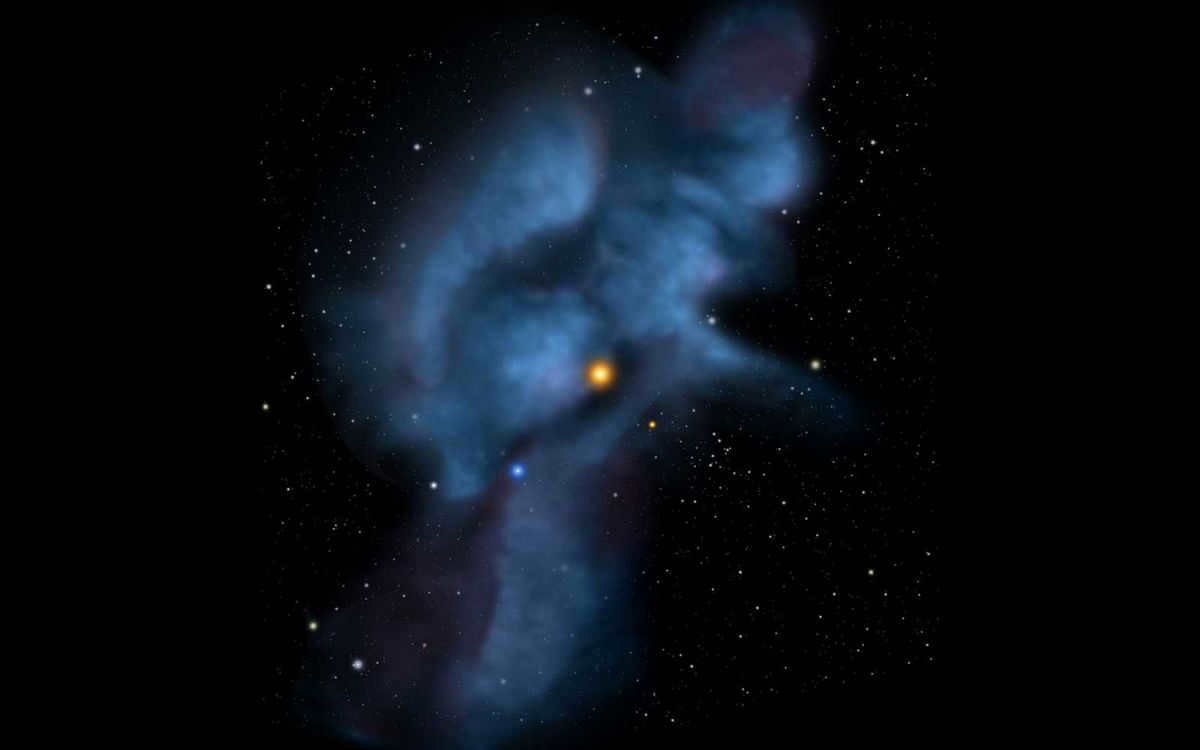

This is your celestial location, and it will revolutionize your perspective on everything:
Earth, Solar System, Oort Cloud, Local Fluff, Local Bubble, Orion’s Arm, Milky Way Galaxy, Local Group, Virgo Superscope, Laniakea Superscope, Universe.
Understanding the first two concepts is simple, but can you comprehend the remaining ones? Let’s analyze each one individually and establish our current position precisely.

The Planet Earth
We are all familiar with Earth. It is an ancient planet, estimated to be around 4.5 billion years old. Earth is a solid planet located in the habitable zone of our solar system, orbiting the sun. As far as we know, it is the only place in the universe where life exists. Earth completes one revolution around the sun in approximately 365.25 days, which is equivalent to a distance of 92 million miles or one astronomical unit (a.u.). This unit is commonly used to measure distances within our solar system.
The Sun, a star that is 4.5 billion years old and in the middle of its life cycle, is not particularly special. It is surrounded by eight planets that orbit it in a single plane. Beyond the farthest planet, Neptune, there is a region called the Kuiper belt, which is shaped like a doughnut and contains minor planets, asteroids, and comets. The distance between the solar system and the next nearest star, Proxima Centauri, is 4.25 light-years. It would take approximately 18,000 years for a spacecraft to travel that distance.
The Oort Cloud
Located beyond the outer boundaries of our solar system, the Oort Cloud is a vast and spherical region of interstellar space that harbors a multitude of icy comets. Despite its mysterious nature, whenever we gaze at the night sky, we are actually peering through the Oort Cloud, catching a glimpse of the enigmatic wonders that lie beyond. Positioned at a distance ranging from 2,000 to 100,000 astronomical units from the Sun, which is approximately equivalent to two light years, the Oort Cloud continues to captivate and intrigue astronomers worldwide.
Local Fluff
Commonly referred to as the Local Interstellar Cloud (LIC), we find ourselves situated on the periphery of the interstellar dust clouds within the Milky Way galaxy. This particular expanse of space boasts a modestly increased concentration of hydrogen gas, which stands as the most prevalent molecule throughout the cosmos. Notably, during the year 2019, scientists conducting research in Antarctica made a groundbreaking revelation: they stumbled upon particles of stellar dust, remnants of supernovae detonations, nestled within the ethereal “fluff”.
Local Bubble
The Local Bubble is a region of rarefied gas in space that is shaped like an egg and is currently located at the center. It spans a distance of 1,000 light-years. Within this bubble, thousands of other stars are accompanying the sun as it travels. It is believed that the Local Bubble is responsible for the formation of stars.
Orion’s Arm
The Milky Way, our galaxy, is a spiral galaxy that consists of a spinning disk containing stars, gas, and dust. It also has a central bulge in the middle. When we observe the Milky Way, we see the Sagittarius Arm, which contains a concentration of stars known as the central horn. However, our location is within the Local Bubble of the Orion Arm. It takes our sun approximately 230 million years to complete one orbit around the galactic center of the Milky Way, which is located 27,000 light-years away.
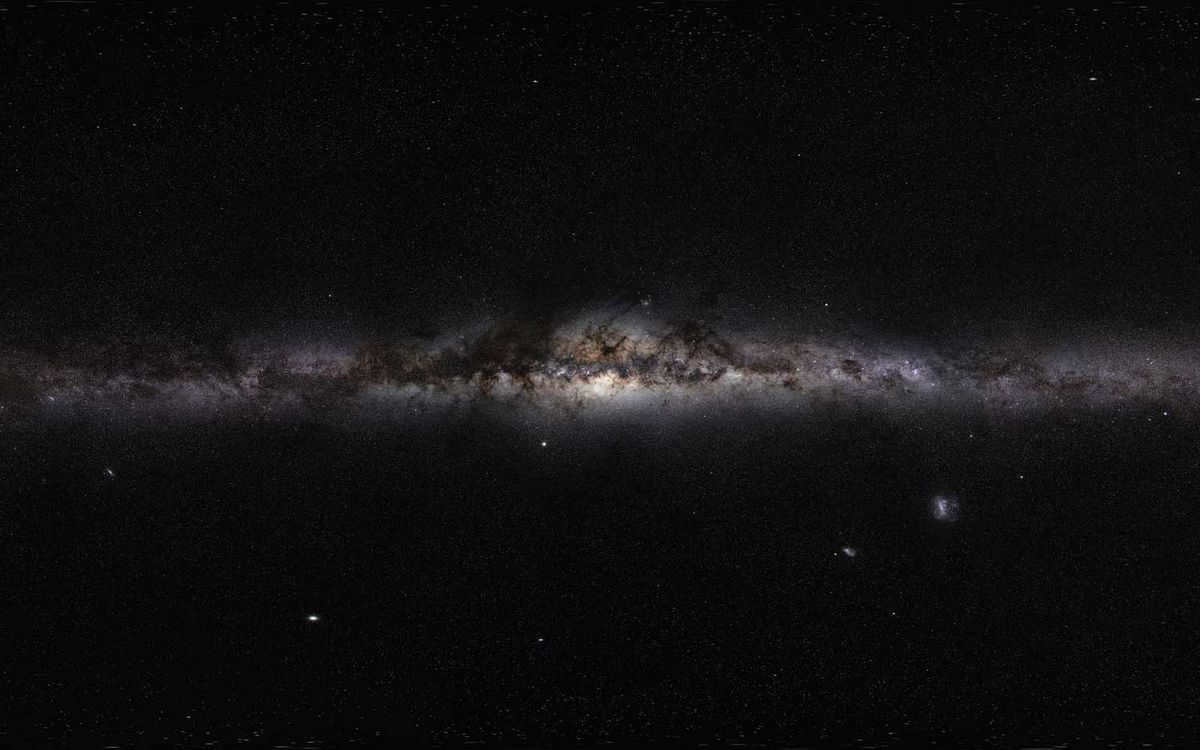
The Galaxy of Milk
The Milk Path is a spiral galaxy that spans about 100,000 light years. Inside our abode galaxy, there are approximately 400 billion other suns. It is assessed that within the Milky Way, there are no less than 100 billion other planets, out of which up to 10 billion planets are capable of sustaining life.
Neighborhood Association
Groups of galaxies are a common occurrence in the vast universe. This particular group, which consists of approximately 50 smaller galaxies known as “dwarfs,” orbits around two much larger galaxies: the Milky Way and the Andromeda Galaxy. Experts predict that these two massive galaxies will collide in approximately 4 billion years.
If you find yourself in the Southern Hemisphere, you can easily observe two bright dwarf galaxies as they orbit around the Milky Way. These galaxies are called the Large Magellanic Cloud and the Small Magellanic Cloud, and they present a breathtaking sight when viewed from locations such as Namibia, South Africa, and Australia. On the other hand, the Andromeda Galaxy can be seen from any part of the Earth, provided that you have access to a dark sky. The best time to observe it is between the months of August and October.
Virgo Supercluster
If you locate the bright spring star Spica in the constellation Virgo, you will be looking towards the Virgo supercluster. This region is home to approximately 100 small groups of galaxies, including our very own Local Group.
The Laniakea Supergroup
Laniakea, which is pronounced lah-nee-ah-ke-ah, can be described as a “galactic city.” Groups of galaxies exist within clusters and are connected by a network of threads, resembling a string of pearls. The Laniakea supergroup is an immense structure, spanning 500 million light-years in diameter and hosting 100,000 galaxies. In Hawaiian, Laniakea means “vast sky,” and it is also referred to as the Local Supergroup. Beyond Laniakea lies the observable Universe, estimated to contain two trillion galaxies.
This explanation of your mind-boggling cosmic address is truly the ultimate journey.
Every living entity on Earth serves a vital purpose, whether it be a plant, animal, or bacterium. Each of them plays a crucial role in preserving the delicate equilibrium of the natural world. It is through these harmonious interactions that life on our planet is able to thrive.


Planet Earth, a heavenly sanctuary in the vastness of the cosmos.
The same holds true within the vast expanse of the universe, where each celestial body, be it a planet, star, or asteroid, plays a vital role in upholding cosmic equilibrium. Hence, the inquiries we shall endeavor to address are as follows: What purpose does Earth serve within the Universe? Could it be that our planet serves as a realm of retribution, a sanctuary for healing, or perchance, a utopia? Or could it be that our planet serves as an incubator for a budding civilization?
It remains an undeniable fact that our existence is ephemeral, leaving us with scarce time to fathom our own being, let alone comprehend the enigmatic wonders of the world. Nonetheless, we must acknowledge that we are not the sole inhabitants of the cosmos.
Billions of years in the past, when the entire universe originated from the immense energy stored within atoms, giving birth to planets and celestial bodies, each planet within the solar system was inhabited by a distinct race of intelligent beings. These beings, including Reptilians, Atlanteans, Leviathans, and Anunnaki, coexisted harmoniously.
The Anunnaki, the noblest species among the races in our galaxy, chose Earth as their home while the others resided on planets that suited them. Eventually, the Anunnaki made a decision to transition to other dimensions, leaving behind little evidence of their existence.
However, the Anunnaki left a remarkable legacy on Earth. They held a deep affection for our planet and thus, they created humans to act as caretakers and protectors of this magnificent realm. For thousands of years, they lived alongside us, imparting knowledge and wisdom.
After that, the “elders” ventured into alternate dimensions and sectors of the cosmos, pledging to return armed with even more advanced knowledge, which would bring numerous benefits to both the planet and its inhabitants.
Consequently, Earth was conceived as a sanctuary for intergalactic explorers. Our planet stands as an authentic celestial oasis, boasting crystalline water lagoons amid the frigid darkness of outer space. It now falls upon humanity alone to preserve Earth’s status as a paradise, preventing it from descending into a desolate realm akin to the forsaken Mars. Armed with this profound understanding of our purpose on Earth and in the Universe, the time has come for us to unite and transform Earth into an even more remarkable place to call home.
What is the reason for the Anunnaki’s potential return to Earth?
One hypothesis suggests that the Anunnaki might come back to Earth with the intention of rectifying the damage they have caused, particularly in relation to our “junk DNA”. This action would aid in the advancement of spiritual enlightenment and the development of consciousness in the younger species (humans), unlocking dormant potentials.

The Earth was inhabited by the Anunnaki.
In a recent interview, Stan Deyo, a researcher and author of numerous studies on UFOs, stated that he has insider information. According to him, NASA and the Pentagon are convinced that the Anunnaki will come back to Earth when the planet-ship Nibiru arrives.
It is actually believed that the gods are already present on Earth and they are devising a plan to establish “contact” with humans gradually. According to Sumerian mythology, the Anunnaki are acknowledged as extraterrestrial deities.
According to ancient texts, there are mentions of a group referred to as “heavenly descendents”. This group was created by a collective of deities from a different realm. They are an advanced and formidable species of kind-hearted “gods”, although there is a mix of personalities within their ranks. It is believed that they are responsible for establishing the environment on Earth and subsequently creating mankind.
Leave your comment Don’t want to reply? No problem
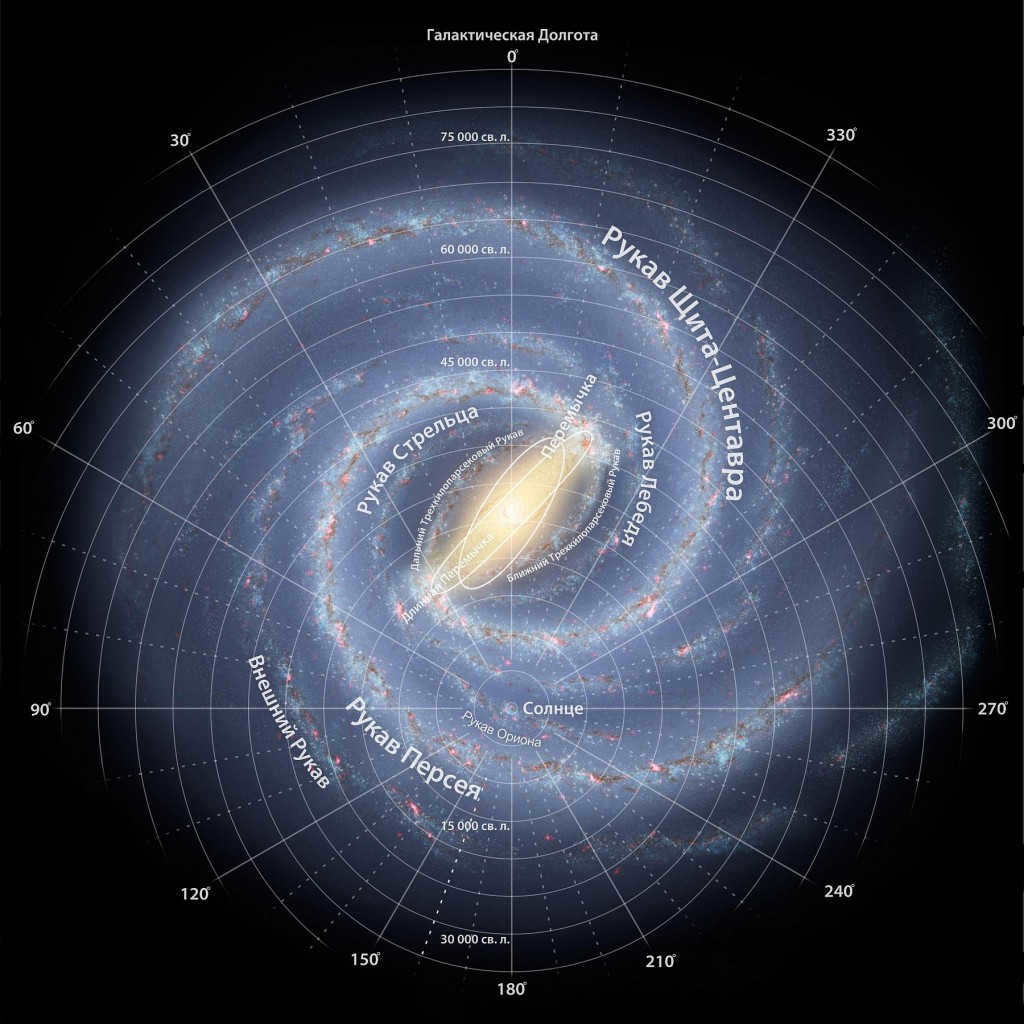
A galaxy is a collection of stars held together by the force of gravity. How vast is it?
How large is a constellation
Imagine that our star, the Sun, is just one out of an astounding number of stars. The Milky Way is our galaxy, encompassing our solar system and our home planet Earth within it. There are roughly 200 billion such entities within our constellation! Nearly all celestial objects visible to the naked eye in the night sky are part of the Milky Way.
The position of the solar system
The solar system is situated on the outer region of our constellation, precisely on one of the spiral arms. This indicates that the Milky Way is essentially a spiral galaxy, resembling a flat disk that extends outwards in a spiral pattern.
In terms of distance, the Sun is located approximately 25 thousand light-years away when observed from the central reference point of the constellation. The Milky Way has a width ranging from 80,000 to 120,000 light-years. It’s worth noting that the thickness of the constellation is relatively small, measuring around 7 thousand interstellar years.
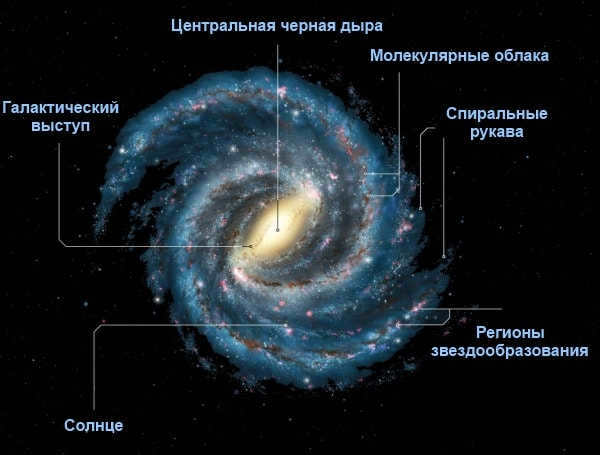
Comparing Sizes
Understanding the vastness of these measurements can be challenging, so let’s put the size of the Milky Way into perspective. If we were to scale down the galaxy to the size of a soccer field, the solar system would be equivalent to a tiny grain of sand, located on one of the outer edges.
Consider this: the Earth and other stars are hurtling through space at a mind-boggling speed of approximately 250 kilometers per second. That’s incredibly fast! However, the Milky Way is so immense that it would take our solar system a staggering 200-250 million years to complete a single orbit around it!
